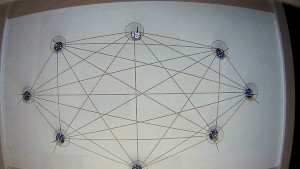Network Control Systems for Swarm Robotics
Multi-Robot Disinfection Operation
~~Coded In MATLAB
Implemented on Real robots, Georgia Tech @Robotarium
In this hypothetical scenario, the world has been ravaged by a global pandemic. To promote social distancing and curb the spread of the disease, there has been a boom in the deployment of robotic systems which have to assist in performing tasks such as symptom monitoring, area disinfection, deliveries, etc.
Decentralized controllers are designed to enable a team of robots with disinfecting certain high-traffic areas in a clinical setting.
The agents will be deployed from a disinfectant refueling station, which they must revisit after each use.
For cyber-security reasons, agents are not connected to the existing communication infrastructure and are not able to communicate with one another. They are equipped with short-range radio localization equipment to detect each other's position and identities, and their interactions can be modeled using a ∆-disk graph. For further security, only a single agent is aware of the navigation waypoint locations, assigned at random after each refueling trip. Thus, agents must remain connected to ensure they will not be stranded roaming the halls.
To safely navigate the environment, agents are able to detect obstacles within their sensing range. Each agent is equipped with eight range sensors, uniformly spaced around the body of the robots on an inertially-fixed rotating base (i.e., in the fixed directions {0 ◦ , 45◦ , . . . , 315◦} from the center of the robot). Each sensor returns the distance to any object detected in the range [δ, ∆].
Within the target disinfection area, all agents begin to spray the disinfecting solution in a radius of δ around each robot. Beacons in the room allow for all agents to be aware of the disinfection domain.
Avoiding Collision
~~Coded In MATLAB
Implemented on Real robots, Georgia Tech @Robotarium
In this Project, we avoid collisions between the various robots. We implement this by adding state-dependent edge weights, i.e., weights that will depend on the distance between neighboring agents
(Wij (xi − xj)). Here Wij are the weights of the robots while xi-xj are the distances between the robots


